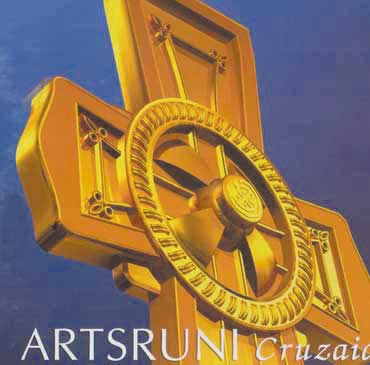Sebouh Krioghlian
Staff Writer
Band: Artsruni
Album: Cruzaid
Year: 2002
Label: Musea Records, France
 While randomly searching for some modern Armenian music, I came across a band called “Atsruni,” whose music completely took me by surprise. The website that aided me in discovering this band, http://www.arminrock.am/ had a long list of modern Armenian bands with music files that enable you to listen to their music. Only after having gone through the majority of the list did I come across “Artsruni,” whose music samples off the album Cruzaid (2002), specifically drew my attention due to their high quality sound production and music played by highly talented and creative musicians. Cruzaid happened to be “Arstruni’s” first studio album. Previously they had recorded two live albums, The Lost and Found (2001) and Live Cuts (2002).
While randomly searching for some modern Armenian music, I came across a band called “Atsruni,” whose music completely took me by surprise. The website that aided me in discovering this band, http://www.arminrock.am/ had a long list of modern Armenian bands with music files that enable you to listen to their music. Only after having gone through the majority of the list did I come across “Artsruni,” whose music samples off the album Cruzaid (2002), specifically drew my attention due to their high quality sound production and music played by highly talented and creative musicians. Cruzaid happened to be “Arstruni’s” first studio album. Previously they had recorded two live albums, The Lost and Found (2001) and Live Cuts (2002).
The band includes Vahagn Amirkhanyan on electric guitar, Arman Manukyan on flute, Artur Molitivin on bass, Levon Hakhverdyan on drums, Lilianna Hakhverdyan on other percussion instruments, and most importantly, Vahan Artsruni, the creator of the band, on guitar and vocals. Vahan Artsruni has previously been involved with a wide range of musical styles, having given concerts with the Armenian National Symphony Orchestra, where his instrumental pieces off his record Ethnophonica were played. He has also written chamber music on another album, Komitas. Ten Revelations, which was later performed by the Naregatsi Chamber Orchestra and the Shoghakat choir.
The music of “Artsruni” is very different from Vahan’s previous work, where the Armenian influence is the only parallel that could be drawn between them. The music featured on the Cruzaid album is a mix of progressive rock and jazz with varying amounts of Armenian-influenced melody. Most of the music off the album has no vocals, while the little that does, is sung in Armenian. Each instrument has a significant role in the music, adding many intricate layers to the product. Furthermore, the introduction of a flute adds great character to the music and especially stands out throughout this album, supplying the majority of the folk melodies, which interweave smoothly with the more modern music of the band. The album as a whole is very relaxing, yet within each track there are many separate moods varying from calmer and sweeter passages to faster-paced and dynamic ones.
The most memorable tracks are “Cruzaid (part 2)” and “Anush Garun.” “Cruzaid (part 2)” is definitely one of the more technical tracks, featuring fast tempos and great intensity, which allow the rhythmic portion of the band to reign freely. On the other hand, “Anush Garun” is a much calmer and emotional track, which especially allows the flutist and the guitarist to shine.
In conclusion, even though this is not an album to sing along to or dance to, it is definitely one that has a high replay value, which can be listened to and appreciated time and again for its successful fusion of modern rock and Armenian music.
 Hye Sharzhoom Armenian Action
Hye Sharzhoom Armenian Action